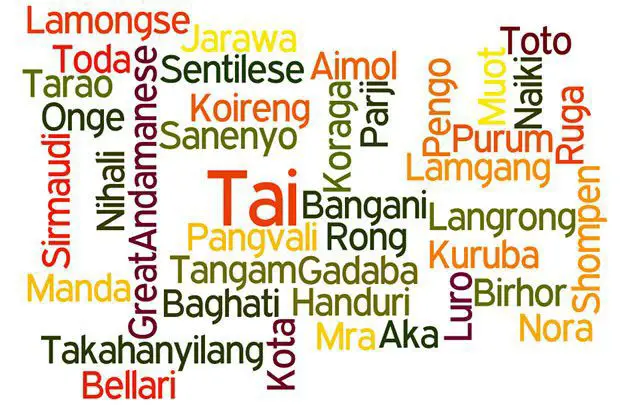8 Endangered Languages of India Heading Towards Extinction

India is a country whose linguistic richness plays a key role in maintaining its social and cultural diversity.
Languages of India trace their roots back to several language families. The major ones being the Indo-Aryan languages spoken by 75% of Indians and the Dravidian languages spoken by 20% of Indians while other languages belong to the Austroasiatic, Sino-Tibetan, Tai-Kadai, and a few other minor language families. It has the world’s second highest number of languages.
As per the Census of India of 2001, India has 122 major languages and 1599 other languages. Unfortunately, many rich languages of India are on the verge of extinction. While the other 191 languages are classified as vulnerable, definitely, severely or critically endangered languages. Here are 8 Critically Endangered Languages from different corners of the country which need to be saved from extinction.
1. Aimol ( Manipur):

Aimol or Aimal is the language spoken by the Aimol tribe of Manipur, India. It has less than 3,000 speakers worldwide. Aimol is spoken primarily in the Chandel, Churachandpur and Senapati, districts of Manipur. Aimol is mutually intelligible with Kom.
As per reports, all the old Kuki languages, including Aimol, are merely dialects of the same language. There are almost no written records of this language. Younger generations have based their linguistics on the Latin script, while others have based it off of Manipuri written in Bengali script. As per 2001 census with 2,700 native speakers, Aimol language is critically endangered.
2. Gutob (Andhra Pradesh & Odisha):

The Gutob language also known as Bodo Gadaban is a Munda language of India. The speakers of this language are mainly concentrated in Koraput district of Odisha and Visakhapatnam district of Andhra Pradesh. This language is also known as Gadba, Gutop, Gudwa, Godwa, Gadwa, and Boi Gadaba.
This language belongs to the Austro-Asiatic language family particularly to the South Munda subgroup of the Munda branch. With approximately 40,000 speakers, the Gutob language is considered to be critically endangered. The hydroelectric projects in the area have displaced Gutob people from their traditional villages.
3. Jarawa ( Andaman Islands):

Jarawa is a descendant of a parent language known as Proto-Andamanese. It belongs to the Organ language family. It is the language of the Jarawa tribe of the Andaman Islands, especially the hunter-gatherer communities.
The ancestors of the Jarawa are believed to be part of the first successful human migrations out of Africa. The Jarawas have no system of writing and only drawings and gestures are used as a means to communicate. Currently, with a population of only 270, the community, as well as the language, is a threat. Jarawa is an official language in India, specifically the Andaman Islands and is considered vulnerable.
4. Kota (Tamil Nadu):

With about 900 native speakers in the Nilgiri hills of Tamil Nadu state of India, Kota language is under threat due to the greater social status of the neighboring languages. It belongs to the Dravidian language and may have originated from Old Kannada and has a close relation with Toda language.
The origin of the name Kota is derived from the Dravida root word ‘Ko’ which means Mountain. It is spoken mainly by the tribal Kota people. The language is critically endangered with a Kota population of only 2500.
5. Langrong (Tripura, Assam & Mizoram):

Recorded as Langrong by UNESCO, Ranglong language is also known as “Riam Chong”. It belongs to Sino- Tibetan language family and is a Kukish Kuki-Chan language of India and Burma. It is spoken in Northeast India in the region of Tripura, Assam, and Mizoram.
Ranglong language is a tonal, monosyllabic, contextual, agglutinative, and an ergative language. The Ranglong speakers as per G.A. Grierson in 1904 were 6266, in 2017. Ranglongs at present are about 15000 in number and the language has officially been declared as a critically endangered language.
6. Mahasu Pahari (Himachal Pradesh):

Mahasu Pahari which is also known as Mahasui or Mahasuvi is a Western Pahari language mainly spoken in Himachal Pradesh. It is estimated that the speaking population is about 1,000,000 as per 2001 census. It is primarily used in home and for religious purposes.
The language has developed several dialects as per different locations. It is understood and spoken by people of vital age group. It is considered critically endangered as the number of people speaking it is constantly going down.
7. Nihali (Madhya Pradesh & Maharashtra):

Nihali, also known as Nahali is a moribund language spoken in west-central India (in Madhya Pradesh and Maharashtra). It is a language of the Nihali tribal people of the region. It had approximately 2,000 speakers in 1991 out of an ethnic population of 5,000.
There are no other surviving monolingual speakers of the language making it a critically endangered language. Currently, people who are well versed in modern Nihali are likely to speak varieties of Hindi, Marathi or Korku as well.
8. Toto (West Bengal):

Toto language is spoken on the border of West Bengal (India) and Bhutan by the Toto tribe. It belongs to the Sino- Tibetan language family. This language is listed as a critically endangered language by UNESCO, with an estimation of 1,000 speakers. However, this language is still spoken in most families of the Toto tribe.
There are many more languages which are critically endangered and vulnerable. In future, many more are going to join the list if proper preservative measures are not taken on time.
“Protection and Preservation of Endangered Languages of India” is a scheme initiated by the Government of India as a means of protecting and preserving the Critically Endangered Languages of India. As per the scheme, The Central Institute of Indian Languages (CIIL), Mysore is working on protection, preservation, and documentation of all the mother tongues/languages of India which are spoken by less than 10,000 speakers.
Read Also: Five Dead Languages you should Know about



